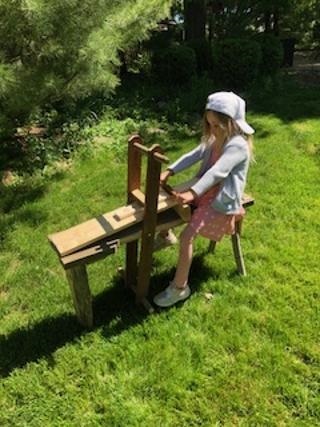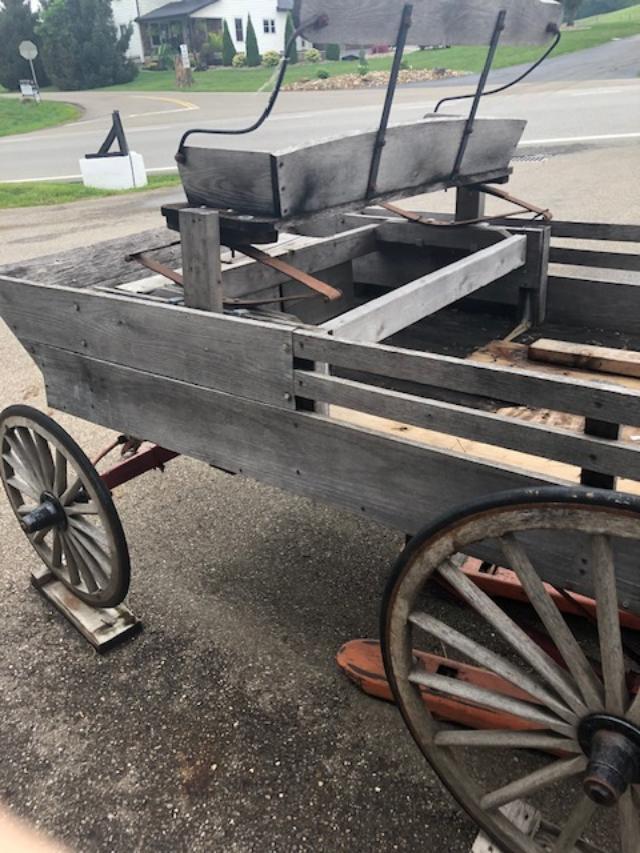
Ride into the sunset on a shaving horse
by Trey Nosrac
Trey does woodworking. Turning a tree or a hunk of wood into an object is remarkably satisfying, and woodworking is much cheaper than seeing a therapist. Trey particularly enjoys retro woodworking, reproducing wooden objects from history without power tools.
For example, this is a photo of a young Abigail aboard a shaving horse. A shaving horse is a tool, a combination of viseand workbench, not to be confused with a sawhorse for lumber support or a trihorse, a portable woodworking station. I made this shaving horse by viewing pictures in a book and using fallen trees in my backyard.
To use a shaving horse, the woodworker straddles the seat as if sitting on the back of a horse, and then the worker pushes down on their feet as if they were trying to stand up in the stirrups. This action with your feet pinches the wood you are working on and holds it firm as you pull a drawknife towards you. A shaving horse is excellent for creating a round profile from a square or shapeless piece of wood. Long before power lathes, shaving horses (sometimes called “Bodgers benches”) were often used to form chair legs, posts, or spokes for wagon wheels.
You can buy a shaving horse, build a modern one, or find a prefab horse for assembly. However, some of us woodworkers enjoy the old-fashioned method of taking a tree and creating a tool our forefathers used for centuries.
This summer, while busy doing a combination of nothing and nonsense at my own pace, I took the photo below.
I found the vehicle in an Ohio village and took a photo. I’m not sure what the technical name for this horse-drawn cart is, nor do I know its age or history, but to my eyes, this vehicle could be called a mini buckboard. Except for a few metal parts, the construction of the smallish contraption was very rudimentary. Now, what do these photos have to do with harness horse racing?
Not much. However, the photos planted a seed in my mind. They might find a few roots with a few of you.
My partner and I race stakes horses, usually just one per season. Therefore, we occasionally find ourselves as city dwellers who own a young horse. We strive to find good homes for these animals, but this relocation to a good home is not always easy. Part of the business is to send unproductive horses to a sale or online auction, take what you get, and turn the page, or you will soon have a herd of expensive pets.
I have a weird idea. When I face placement for my next trotter, I will seriously consider keeping this horse and paying for equine room and board at a nearby farm. However, merely driving out to the farm a few times a month to gaze into those brown eyes and scratch my horse’s nose does not hold much charm. DOING something enjoyable with my horse is a horse of a different color.
Ergo, this photo of a buckboard-like vehicle is thumbtacked on my workshop wall. The shaving horse I built is in my backyard. Building this crude vehicle would be a fun challenge. The cost of construction would be minimal. Customizing the construction would also be alluring.
If the stars align, I will look for a retirement home for my trotter at a location that offers some paths, fields, and lanes to take drives and ramble. I might build a wooden sleigh for snowy winter days or attempt to construct a more complex historical horse-drawn vehicle. Keep your eyes open. You may someday see me and some acquaintances plodding down country paths or across the fields.
If I build it, they will come, I will have a challenging project, and one more horse will have a happy ever after.















